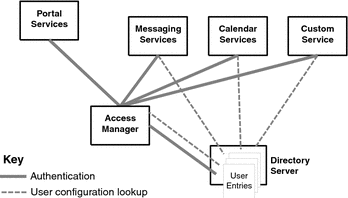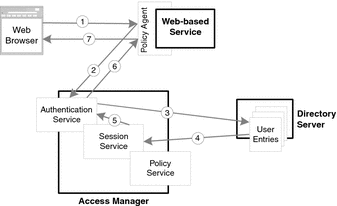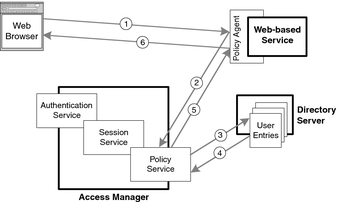Chapter 3 Java ES Integration Features
This chapter provides conceptual and technical background for understanding features that play key roles in integrating Java ES components into a single software system. These features help you understand some of the benefits of using Java ES, as compared to manually integrating disparate infrastructure products.
The chapter contains the following sections:
The Java ES Integrated Installer
All Java ES components are installed using a single installer. The Java ES installer transfers Java ES software to a host system. The installer lets you select and install any number of Java ES components on a host in your computing environment. The installer also provides for some installation-time configuration, depending on the particular Java ES components being installed.
The Java ES installer does not, in itself, perform distributed installations. To deploy a distributed Java ES software solution, you use the Java ES installer to install the appropriate components on each computer in your environment, one computer at a time. You must use a reasonable sequence of installation sessions and configuration procedures, based on your deployment architecture and component dependencies.
The installer runs interactively in both a graphical mode and a text-based mode, and also provides a parameter-driven silent installation mode. In addition to English, the installer supports the following languages: French, German, Japanese, Korean, Spanish, Simplified Chinese, and Traditional Chinese.
This section discusses aspects of the integrated Java ES installer. For more detailed information, see the Sun Java Enterprise System 5 Installation Guide for UNIX.
Preexisting Software Checking
The installer examines the host on which you are installing and identifies the Java ES components that are already installed. The installer then checks at several levels to ensure that all existing components are at the appropriate release level to interoperate successfully. The installer informs you about those software components that are incompatible and must be upgraded or removed.
Similarly, the installer checks for Java ES shared components such as J2SE or NSS that are already installed and lists any incompatibilities (see Shared Components). If you proceed with installation, the installer automatically upgrades the shared components to newer versions.
Dependency Checking
The installer does extensive checking of components to verify that the installation components you select function properly together. Many components have dependencies on other components. For this reason, when you select a component to install, the installer automatically includes the components and subcomponents upon which the selected component has dependencies. You cannot deselect a component if another selected component depends upon that component locally. However, if the dependency is not local, you receive a warning but can proceed under the assumption that the dependency is satisfied by a component on a different host computer.
Initial Configuration
Many Java ES components require initial configuration before they can be started. For some components, the Java ES installer is used to perform this initial configuration.
You can choose to have the installer perform this initial configuration (Configure Now option) or to install the software without performing initial configuration (Configure Later option), in which case you must explicitly configure each installed component after installation is complete.
If you choose to have the installer do the initial configuration, you supply the required configuration information during installation. In particular, you can specify a set of parameter values that are common across all component products, such as an administrator ID and password.
Uninstallation
Java ES also provides an uninstallation program to remove components that were installed on the local computer by the Java ES installer. The uninstaller checks for local dependencies and issues warnings when a dependency is found. The uninstaller does not remove Java ES shared components. As with the installer, the uninstaller can be run in graphical mode, text-based mode, or silent mode.
System Monitoring Services
Java ES includes a new monitoring feature that provides real-time monitoring of system services. Monitoring is implemented by the Sun Java System Monitoring Framework (shared component), and the Sun Java System Monitoring Console (product component). The Monitoring Framework is automatically configured and enabled to gather data for each installed Java ES component, and the Monitoring Console is the graphical interface used to view the monitored data. The Monitoring Console is a component that can be selected during the installation of Java ES, and the Monitoring Framework is automatically installed.
Monitoring is the process of gathering runtime data, exposing it, and computing quality of service criteria so that system administrators can assess performance and receive alarms. During runtime operation, administrators interact with the Monitoring Console to view performance statistics, set thresholds to monitor dynamically, define custom monitoring jobs, and acknowledge alarms.
Integrated Identity and Security Services
An important feature of Java ES is its integrated management of user identities and its integrated authentication and authorization framework. This section provides the technical background for understanding the integrated identity and security services provided by Java ES.
Single Identity
Within a Java ES environment, an end user has a single integrated identity. Based on this single identity, a user can be allowed access to various resources, such as a portal, web pages, and services such as messaging, calendar, and instant messaging.
This integrated identity and security capability is based on close collaboration between Directory Server, Access Manager, and other Java ES components.
User access to a Java ES service or resource is achieved by storing user-specific information in a single user entry in a user repository or directory. This information typically includes data such as a unique name and password, an email address, a role in an organization, web page preferences, and so forth. The information in the user entry can be used to authenticate the user, authorize access to specific resources, or provide various services to that user.
In the case of Java ES, user entries are stored in a directory provided by Directory Server. When a user wants to request a service provided by a Java ES component, that service uses Access Manager to authenticate the user and authorize access to specific resources. The requested service checks user-specific configuration information in the user’s directory entry. The service uses that information to perform the work requested by the user.
The following figure illustrates access to user entries for performing user authentication and authorization and for providing services to a user.
Figure 3–1 Single User Entry Supports Many Services

One of the features derived from this system is the ability of a web-based user to sign on to any Java ES service, and in so doing be automatically authenticated to other system services. This capability, known as single sign-on, is a powerful feature provided by Java ES.
Authentication and Single Sign-On
Access Manager provides Java ES authentication and authorization services. Access Manager uses information in Directory Server to broker the interaction of users with Java ES web services or other web-based services in an enterprise.
Access Manager uses an external component known as a policy agent. The policy agent plugs into the web server hosting a service or resource being secured by Access Manager. The policy agent intercedes on behalf of Access Manager in requests made by users to the secured resources. For some Java ES components such as Portal Server, the functionality of the policy agent is provided by the Access Manager SDK subcomponent.
Authentication
Access Manager includes an authentication service for verifying the identities of users who request access by way of HTTP or HTTPS to web services within an enterprise. For example, a company employee who needs to look up a colleague’s phone number uses a browser to go to the company’s online phone book. To log in to the phone book service, the user must provide a user ID and password.
The authentication sequence is shown in Figure 3–2. A policy agent intercedes in the request to log on to the phone book (1), and sends the request to the authentication service (2). The authentication service checks the user ID and password against information stored in Directory Server (3). If the login request is valid, the user is authenticated (4), (5), and (6), and the company phone book is displayed to the employee (7). If the login request is not valid, an error is generated and authentication fails.
The authentication service also supports certificate-based authentication over HTTPS.
Figure 3–2 Authentication Sequence

Single Sign-On
The authentication scenario discussed in the previous paragraphs glosses over an important step. When a user’s authentication request is verified, the Access Manager’s session service is engaged (4), as shown in Figure 3–2. The session service generates a session token, which holds the user’s identity information and a token ID (5). The session token is sent back to the policy agent (6), which forwards the token (as a cookie) to the browser (7) from which the authentication request was made.
When the authenticated user attempts to access another secured service, the browser passes the session token to the corresponding policy agent. The policy agent verifies with the session service that the user’s previous authentication remains valid, and the user is granted access to the second service without being asked to reenter a user ID and password.
Accordingly, a user needs to sign on only once to be authenticated to multiple web-based services provided by Java ES. The single sign-on authentication remains in effect until the user explicitly signs off or the session expires.
Authorization
Access Manager also includes a policy service that provides access control to web-based resources in a Java ES environment. A policy is a rule that describes who is authorized to access a specific resource under specific conditions. The authorization sequence is shown in the following figure.
Figure 3–3 Authorization Sequence

When an authenticated user makes a request for any resource secured with Access Manager (1), the policy agent notifies the policy service (2), which uses information in Directory Server (3) to evaluate the access policy governing the resource to see if the user has permission to access the resource (4). If the user has access privileges (5), then the resource request is fulfilled (6).
Access Manager provides the means for defining, modifying, granting, revoking, and deleting policies within an enterprise. The policies are stored in Directory Server and configured through policy-related attributes in organization entries. Roles can also be defined for users and incorporated in policy definitions.
Access Manager policy agents are the policy enforcers. When the policy service rejects an access request, the policy agent denies the requesting user access to the secured resources.
Key Terms in This Chapter
This section explains key technical terms used in this chapter, with an emphasis on clarifying how these terms are used in the Java ES context.
- directory
-
A special kind of database optimized for reading data rather than writing data. Most directories are based on LDAP (Lightweight Directory Access Protocol), an industry-standard protocol.
- policy
-
A rule that describes who is authorized to access a specific resource under specific conditions. The rule can be based on groups of users or roles in an organization.
- single identity
-
An identity that a user has by virtue of a single user entry in a Java ES directory. Based on this single user entry a user can be allowed access to various Java ES resources such as a portal and web pages and services such as messaging, calendar, and instant messaging.
- single sign-on
-
A feature that allows a user’s authentication to one service in a distributed system to be automatically applied to other services in the system.
- © 2010, Oracle Corporation and/or its affiliates
